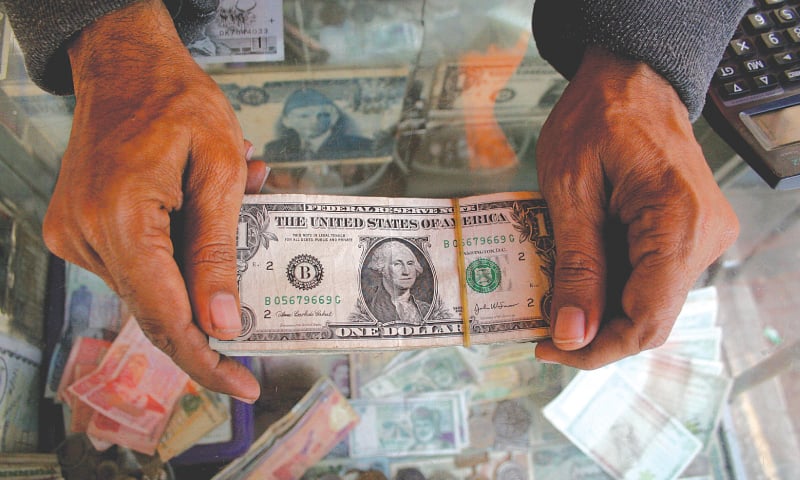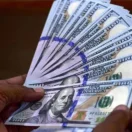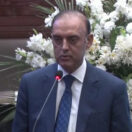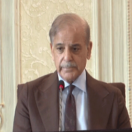By Khurram Husain
Published in DAWN on October 16, 2022
Rarely have things been as messy as they are today.
Political and economic crises are not unusual in Pakistan’s history. But, in previous episodes, it was actually possible to see one or two points of origin from where the troubles were emanating, a relatively clear path out of the crisis was usually visible, and somebody — whether civilian or military — was ready and willing to undertake the task of walking the country down that path. None of that holds true this time.
At a time when global markets — and geopolitics — are wracked by instability, Pakistan is facing a deflating economy, spiralling inflation, the rising arc of terrorism and a political system near paralysis. To this list we can add the aftermath of the most catastrophic flooding the country has ever seen.
Those with a memory may argue that we have faced these issues before, and lived to tell about it.
With global markets in turmoil and the prospect looming of worldwide recession, Pakistan faces a perfect storm of a deflating economy, spiralling inflation, rising terror threats and political paralysis. Is there a way out? And what are its economic managers likely to do?
But today is different. The world is wracked by an economic crisis so complex that one government after another is throwing out the textbook in order to reckon with its impact. But within Pakistan, we have a government that can neither wield power nor surrender it.
We have an opposition so rancorous that it cannot figure out how to recapture the power that was snatched out of its hands a few months ago, nor how to climb down from the fire and brimstone rhetoric it has used to mobilise the masses behind its narrative. Neither of the protagonists have an idea of their endgame here. The result is political paralysis, amid an economy pregnant with pressures of unmanageable proportions.
THE STATE OF THE ECONOMY
The debt burden alone is so high that the country’s foreign creditors are pricing in the possibility of a default on a bond that is maturing in December, barely three months away. Two finance ministers have emphasised that they have no intentions to seek a rescheduling of that payment obligation in December, but the markets are unmoved by these reassurances so far.
Last Monday, the State Bank of Pakistan (SBP) told an analyst’s briefing that the country has ample financing lined up to meet its obligations through the entire fiscal year. But the markets remain sceptical.
Pakistan’s credit rating has been downgraded by Moody’s with a blistering statement, saying the country’s ability to afford its own debt is “one of the weakest among the sovereigns” that the rating agency deals with. Interest payments alone, the agency estimates, will eat up half of government revenue this fiscal year, up from around 40 percent last year.
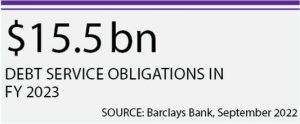
In a snapshot of Pakistan’s external debt service burden released by Barclays Bank in the middle of September, the authors pointed to specific risks facing foreign creditors. “We estimate that Pakistan faces a funding gap of at least $6 billion” in fiscal year 2023 (FY23), the report said. Of the $15.5 billion in debt service obligations falling due in the fiscal year, they said $9.5 billion will be rolled over, since it was from official creditors, and a bond of $1.5 billion is earmarked in the latest budget. “[B]ut refinancing plans for the remaining $4.5bn are not available,” the report pointed out.
On October 10, the SBP tried to dispel this impression. In its monetary policy statement, in which it decided to leave interest rates unchanged, it said “[g]iven secured financing and additional commitments in the wake of the floods, FX [foreign exchange] reserves should improve through the course of the year.”
In a follow-up briefing to analysts given after the statement was released, the SBP said they had commitments of up to $4 billion from multilateral creditors such as the Asian Development Bank, the Asian Infrastructure Investment Bank, the World Bank and the United Nations. They also said they plan to float a bond worth $2 billion this fiscal year.
The numbers provided by the SBP could be enough to plug a hole in the country’s external financing requirements for this fiscal year, provided the inflows they mention actually materialise and Pakistan’s requirements don’t increase further, for example with continued increases in the price of oil in global markets. These are big assumptions.
A WORLD IN TURMOIL
To get an idea of how bad the situation in global markets is these days, consider the red lines that governments around the world are now willing to cross. The European Union (EU) — long the standard-bearer for deregulating energy markets — is now considering price caps, as gas prices surge on the back of the war in Ukraine. This was nearly unthinkable even a few years ago, given the strong commitment to building energy markets that the European Union has shown for many decades now.
In the east, Japan is now gearing up to restart its nuclear reactors and has embraced the idea of investing in a new generation of nuclear power plants. This is a reversal of its policy of phasing out nuclear power altogether after the Fukushima disaster of 2011, and surveys in the country show it has widespread support today, with spiralling liquefied natural gas (LNG) prices in global markets.
Meanwhile, the United Kingdom is looking at the possibility of three hour-long bouts of loadshedding in the winter, when LNG shortages are expected to peak, and Germany has announced a Euro 200 billion plan to pay the gas bills for its households as well as small and medium enterprises through the winter.
To help foot the bill for this mammoth endeavour, they are also about to suspend a constitutional requirement to cap all government borrowing at 0.35 percent of the GDP, a measure that was introduced in 2009 and suspended only once before, in the wake of the Covid pandemic.
With the continued escalation of the war in Ukraine, the prospect of severe gas shortages in the crucial winter months ahead is forcing countries dependent on this vital fuel to abandon long-held convictions and embrace what, until recently, would have been unthinkable for them.
To top it off, the Organisation of the Petroleum Exporting Countries (OPEC) announced on October 6 that it will cut oil production by two million barrels per day, or two percent of global supply. Oil prices rallied on the news, whereas they were on a downward glidepath until then, in anticipation of a lower demand, as recession grips the advanced industrial economies. Prices spiked towards the dreaded $100 per barrel mark within a week of the news. Russia welcomed the announcement while the United States angrily denounced it.
A PERFECT STORM
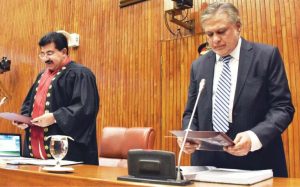
Ishaq Dar finally takes oath as a senator after four years on September 27, 2022. He was immediately made the new finance minister. | White Star
Global energy markets are in turmoil around the world, forcing governments to take extraordinary decisions and promising another flare-up in the US’s relations with oil-producing countries, especially Saudi Arabia. Falling oil prices were also supposed to be the one bright spot in Pakistan’s economic outlook.
Last fiscal year, oil (and its related products) accounted for more than one quarter of the country’s total imports. This year, this percentage was anticipated to fall, thereby helping the country rebuild its foreign exchange reserves that have dropped to slightly more than one month’s import cover. But the OPEC decision (unless reversed) will certainly wipe out this hope.
Beyond energy, the world’s financial markets are being roiled by rising interest rates in the advanced industrial economies, as well as inflation, borne out of the excessive monetary stimuluses extended by these countries in the wake of the Covid-19 pandemic and the lockdowns it necessitated. Such episodes of rate hikes in the advanced economies always have the effect of sucking liquidity out of emerging markets into the safer treasury assets instead.
The results are brutal. Recession, dollar flight and pressures on the exchange rate weigh down heavily upon smaller countries, making it very expensive for them to raise more capital from global markets. According to one widely quoted study by the Global Development Policy Centre at Boston University, for example, 55 economies that are part of the Vulnerable Group of Twenty (V20) could see debt service payments rise to $69bn by 2024 from $61.5bn in 2022, the highest level in the decade so far.
How far Pakistan will be impacted by this development is not known so far. But Pakistan has already seen extreme pressure on its exchange rate.
The government switched finance ministers in the middle of the second peak, but how long the new finance minister Ishaq Dar will be able to keep the dollar down is the billion dollar question these days. Simply put, he does not have the resources to swim against the tide coming his way.
The rupee started the year 2022 at 172 to a dollar and hit two peaks around 240 in July and again in September, before falling to 217 in last week’s trades. The government switched finance ministers in the middle of the second peak, but how long the new finance minister Ishaq Dar will be able to keep the dollar down is the billion dollar question these days.
Simply put, he does not have the resources to swim against the tide coming his way. Only days before his arrival in Pakistan, the European Central Bank announced a historic rate hike of 0.75 percent and promised “several” more to come in the future.
THE CHOICES FOR PAKISTAN
With global energy and financial markets in turmoil, Pakistan faces the daunting task of recovering from the floods, dealing with a political crisis, and undertaking an IMF-mandated adjustment that was already long overdue. Given this weak footing, and the enormity of the challenge standing before it, the country now faces a bitter menu of choices.
Put simply, the government faces three options.
The first is to save the economy and lose the election. Our own history tells us that, whenever a government has to face the electorate during a period of adjustment of the sort envisaged in an IMF programme, they lose. Thus far, no government has had to face the electorate in a general election right after beginning an IMF programme, but the record of by-elections held during an ongoing fund programme shows that defeat is overwhelmingly the outcome for the ruling party.
The reason is straightforward: these programmes push millions of people below the poverty line, and save the state from default by pushing the middle and lower-middle classes into default instead. Today, there are cases of people who have received electricity bills that are larger than, or almost equal to, their combined household income. These people will never accept any reasoning trotted out by the rulers as to why this was necessary.
The second option is to ignore the economy and gun for victory at the polls by swimming against the tide. To do this, the state needs resources — money to spend and dollars to burn. It needs to lower the exchange rate, hold power prices and fuel cost adjustment steady along with the tax burden, and spend money to spur the economy, while ensuring the power system remains functional and fuel imports are not threatened with liquidity shortages.
But does Mr Dar have the dollars to burn or the money to spend to achieve this? With the circular debt already above Rs2.2 trillion — more than double the level it was at back in July 2018 — external debt having jumped from $66 billion at the end of fiscal year 2017 (FY17) to more than $100 billion today, with no corresponding increase in the ability to carry this debt burden, there is no room to borrow more to pay for a strategy like this.

That leaves the third option: muddle through. The government can try to salvage what it can of its electoral prospects by minimising the burden on the populace, while trying to keep the Fund programme on track and prevent a catastrophic default that pushes the country into a situation like the one Sri Lanka finds itself in. And this is precisely what Dar is setting out to do.
We know this is his path by the simple act of observing him in action. On the day Moody’s issued its ratings downgrade, for example, he shot back with an angry response. Speaking to reporters outside the accountability court where he had come in connection with his assets-beyond-means case, he was asked about the ratings downgrade. “I told them if you don’t [reverse] this, I will give you a befitting response in our meeting next week” he replied.
But 48 hours later, he backpedalled. In a press conference on October 9 he reassured the country’s creditors that the December repayment would be made on time. The next day he said he was abandoning the idea of seeking debt rescheduling from the Paris Club, representing bilateral creditors from the Western world. That still leaves China, to whom Pakistan owes $33 billion, or almost exactly one third of its external debt, as an option.
DAR’S DELICATE BALANCING ACT
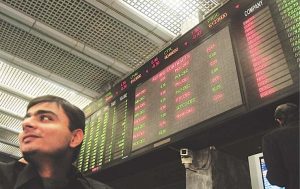
Karachi Stock Exchange | White Star
Dar’s climb down from his retort to Moody’s shows he is not going to try and play hardball with the country’s foreign creditors, even if in a moment of annoyance (court appearances have a way of putting him in a bad mood, even if they go his way) he made it sound like he would deal with them with a strong hand. If this early indication bears out, it shows he will search for that middle ground that allows him to keep the creditors on board without throwing the voter overboard.
But this strategy is fraught with risk and, in seeking to walk this path — which is more of a balancing act rather than an attempt to tackle the underlying issues in the economy — Dar will be faced with his most trying choices.
First of all, he does not yet have a clear idea of how weak the economy’s fundamentals really are. Second, he does not have a clear idea of how strong the tide of uncertainty lapping at the country’s shores really is.
The exchange rate has stabilised somewhat since his arrival, dropping from Rs240 to below Rs220 against the US dollar in a week. But he has promised to take this below Rs200 before the end of the month, and is counting on the dollar inflows the SBP mentioned to achieve this. How far is he willing to push things in order to achieve this goal? How much leeway will he really get to be able to pursue it? Even he does not know yet.
What we do know is that he is preparing to move ahead on the assumption that he will keep the exchange rate steady, like he did last time, despite the headwinds coming his way. He has made a commitment with exporters to price their energy in rupees instead of dollars, against the commitment that the rupee value will not change significantly against the dollar.
In the days to come, he will most likely lock in his Rs200 to a dollar value into other dealings as well, at which point not delivering on it will destabilise his entire web of agreements, through which he intends to move ahead. Once he’s locked into this commitment, he has no choice but to deliver.
The risk inherent in the third scenario — of muddling through — is that a miscalculation can throw the whole thing off at a time when the world is already preoccupied with the Ukraine war, which is showing every sign these days of escalating further.
What if exports go down between now and December, as uncertainty and recession grips the markets where our exports primarily go — the US, UK and EU? What if further interest rate hikes are necessary? What if the IMF does not grant him the leeway to the extent he is looking for? What if the foreign exchange reserves dip, instead of rising and, by December, he has to start weighing which of his commitments he can keep and which ones he cannot? Should he repay that bond or use the money to keep fighting the strengthening dollar?
These are the scenarios facing Pakistan’s economy as the political battle heats up. In times to come, a lot will hinge on how well Dar can recognise the limits of his own power. If he overextends himself — and the risk of that happening is very real — then the spectre of default could return.
But if he is able to navigate the path ahead and make course corrections in time, and tackle the many unknowns that are lying in wait, then it is possible he can navigate the ship of state to its next port of call — the general election.
The writer is a business and finance journalist and analyst.
MISSIONS AND SCENARIOS
The primary tasks for the government for the coming year are threefold…
Averting Default
With barely enough forex reserves to pay for less than two months of imports, and a large debt repayment looming in December, ensuring reserve accumulation will be mission critical going forward.
Not Overdoing It
This works both ways — the government cannot afford to overdo its attempts to stabilise the exchange rate, combat inflation, promote growth and ensure stability as the global environment turns hostile with war, spiralling energy costs and rising interest rates in advanced industrial economies. It also cannot afford to overdo the adjustment demanded by the IMF, for risk of losing the voters. Finding that middle ground will be key, but this is easier said than done, especially where the ground itself is shifting.
Keeping an Even Keel
The political storms are intense in Pakistan. Keeping the ship of state steady through these challenges will take every ounce of political wisdom that is available. Knowing when to fight and when to walk away will be key.
What are the possible scenarios for Pakistan’s economy? There are four, and none foresee the country coming out smelling of roses in the immediate future…
Things Fall Apart
The government is unable to hold the economy steady as exchange rate pressures mount along with energy costs, and the stabilisation effort becomes too costly, causing it to abandon the effort. After that all bets are off.
Stay the Course and Lose the Race
The government is able to hold the IMF programme on track, tweaks and all, but the resultant pain inflicted on the electorate leads to a crushing defeat at the polls. The next government inherits a relatively more stable financial situation, ample fiscal and reserve buffers, and a beaten and cowed opposition, reeling from the public’s wrath.
Politics Wins
Imran Khan succeeds in forcing early elections (unlikely but possible), the stabilisation effort falls apart and the government races in last-ditch efforts to spend its way back into the voters’ hearts and minds. We are back to square one, with the country staring down the barrel of a catastrophic default.
With A Little Help from Friends…
The government manages to secure some debt rescheduling from bilateral creditors such as China, the commitments made by development partners materialise, the reserves stabilise, the exchange rate finds an anchor and inflation ebbs. With some skilful moves at home keeping vested interests in check, the coalition government succeeds in ensuring it remains in power till August 2023. The IMF programme ends in June ’23, the volatility in energy and financial markets ebbs, friendly support remains in place, and the government uses its last three months in power — June, July and August — to gun for growth and create a feelgood factor in the electorate, successfully handing over power to an interim government in preparation for a general election. By October 2023, the country is back on the doorstep of the IMF as all fiscal and foreign exchange buffers have been blown in this short growth spurt. Back to square one all over again. This is the best case scenario.

